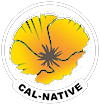
Leymus arenarius
Blue Wildrye

Description
The blue wild rye is a cool season, upright perennial bunchgrass that grows up to 5 ft. tall. It has bluish blades and yellow flowers that bloom in the summer. This grass can tolerate drought, clay soils, and establishes rapidly. The blue wild rye is native to California, the Pacific Northwest and many other areas, preferring open fields, moist meadows and dry hills. Birds, cattle and horses love this grass. It is used for erosion control and sometimes used for reseeding burned areas. This grass can tolerate moist or dry soil. Also known as Elymus glaucus.
Plant Type
Perennial, Grass
Height Range
1-3', 3-6'
Width Range
1-3'
Flower Color
Yellow
Flower Season
Summer
Leaf Color
Blue Green
Bark Color
n/a
Fruit Color
n/a
Fruit Season
n/a
Sun
Full, Half
Water
Low
Growth Rate
Fast
Soil Type
Sandy, Clay, Loam, Rocky, Unparticular
Soil Condition
Average, Poor, Moist, Dry
Soil pH
Neutral
Adverse Factors
n/a
Design Styles
Wetlands, Wild Garden, Woodland
Accenting Features
n/a
Seasonal Interest
Winter, Spring, Summer, Fall
Location Uses
Background, Raised Planter, Walls / Fences
Special Uses
Container, Erosion Control, Screen, Mass Planting, Naturalizing
Attracts Wildlife
Birds, Wildlife
Water Saving Tip:
Move turf away form sidewalks and pavement.
Instead plant shrubs or groundcovers next to the pavement, and water with low-flow drip or bubbler system to eliminate runoff from turf sprinklers